If you want to know about the water supply system in tall building or rainwater harvesting system or principles of water supply, please click the link.
A water supply system is a network of pipes, pumps, storage facilities, and other infrastructure designed to deliver clean and safe water to homes, businesses, and other users. The water supply system is an essential part of modern society, providing water for drinking, cooking, cleaning, and other domestic and industrial uses.
1) Demand / supply

2) Population projection
- It is an estimate of a future population.
- Projection of population for each building shall be made on the basis of its usage.
- Population for each type of building shall be estimated on the basis of information obtained from the users.
- Alternatively, population may be worked on the following basis for different type of buildings:

5 to 15 percent additional population depending on the usage of the building shall be added for visitors and floating population likely to use the building facilities.
3) Sources and supply
- The Source of Supply may be any one or more of the following:

- Municipal filtered water supply from mains miming near the premises.
- Sub-soil sources such as open well and tube wells.
- Surface source such as lakes, rivers or canals.
i) Municipal filtered water supply
- It is from mains near the premises.

- Before tapping municipal supply, permission from concerned authority shall be obtained to draw water from the source.
- Information regarding size of main, location of tapping, pressure available and hours of supply shall be obtained.
ii) Sub-soil sources
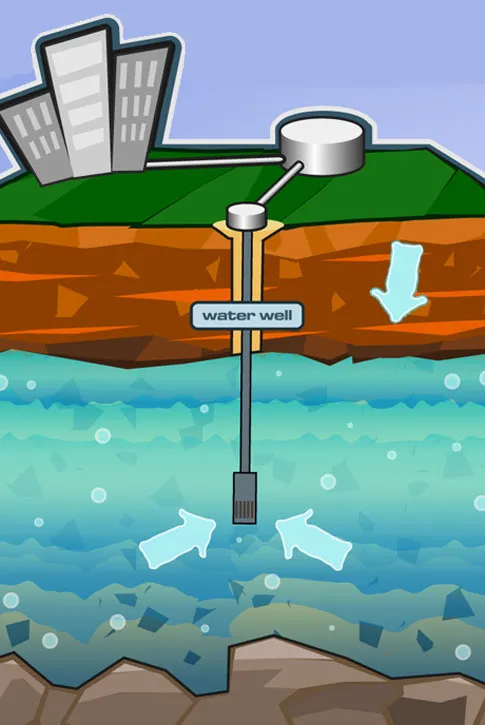
- When water is obtained from a sub-soil source, information regarding the sub-soil water table (high and low), quantity available, quality and portability of water shall be ascertained.
- Use of sub-soil water source shall be determined with or without subsequent treatment on the basis of above analysis.
- Licence for taping sub-soil sources, if required under the prevalent rules in any town/municipality, should be obtained from the Authority.
iii) Surface sources

- When water is obtained from water of any surface source, information regarding the location, high and low water levels, flooding conditions, method of pumping, chemical and bacteriological quality of water in different seasons, and turbidity shall be obtained.
- Desirability and method of treatment shall be based on information so obtained.
4) Water distribution system
For multi-storied buildings
- Water supply from the mains to the building is through one of the following systems depending on the pressure of water in the street mains and the timings of supply. Sometimes, both the systems are used for supply of water.
- Direct supply from mains (upward distribution system)
- Indirect water supply ( Down take supply system)
i) Direct supply system

- Supply of water is given directly to the various floors from the water mains having sufficient pressure for sufficient number of hours.
- This system is used where number floors is not more than two.
- Direct supply from mains to ablutionary taps and kitchen, with WCs and urinals supplied by overhead tanks.
- This system is adopted when adequate pressure is available round the clock at the topmost floor.
ii) Indirect supply system
- When the water pressure in the mains is not sufficient for direct supply, water from the mains can be either:
- Pumped up into the overhead storage tank, usually located at the roof of the building from where the water is supplied to different floors by gravity.
- Stored into the underground storage tank from where water is pumped to the overhead tank and then it is supplied by the gravity.
- Both can be used.
Classification of indirect supply system
- Direct pumping system
- Hydro – pneumatic system
- Over head distribution
Direct pumping system
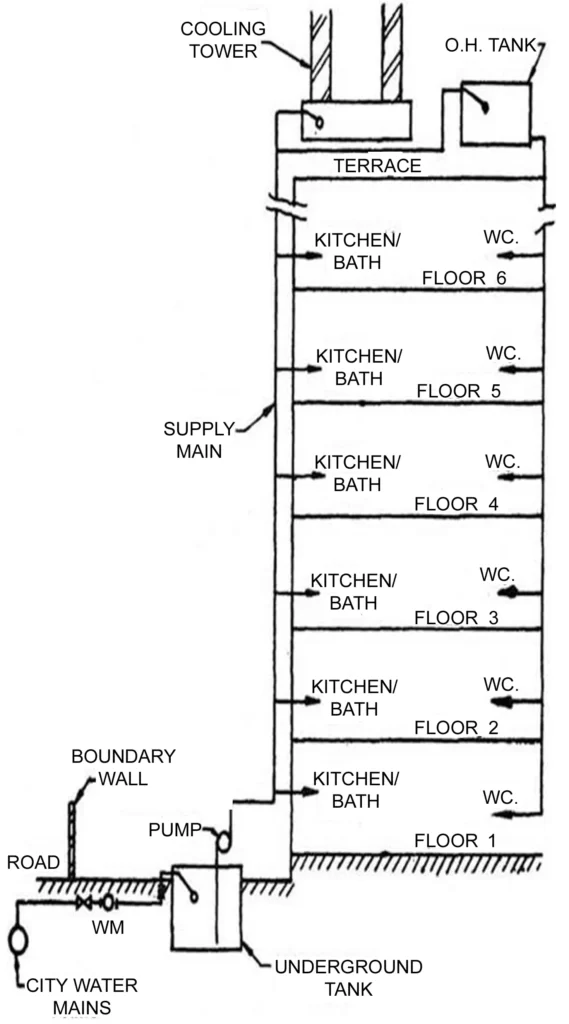
- Water is pumped directly into the distribution system without the aid of any overhead tank, except for flushing purposes.
- The system eliminates the requirements of overhead tanks for domestic purposes (except for flushing) and requires minimum space .
- The system depends on a constant and reliable supply of power.
- The pumps are controlled by a pressure switch installed on the line. Normally a jockey pump of smaller capacity installed which meets the demand of water during low consumption and the main pump starts when the demand is greater.
- Direct pumping systems are suitable for buildings where a certain amount of constant use of water is always occurring.
Hydro-pneumatic system
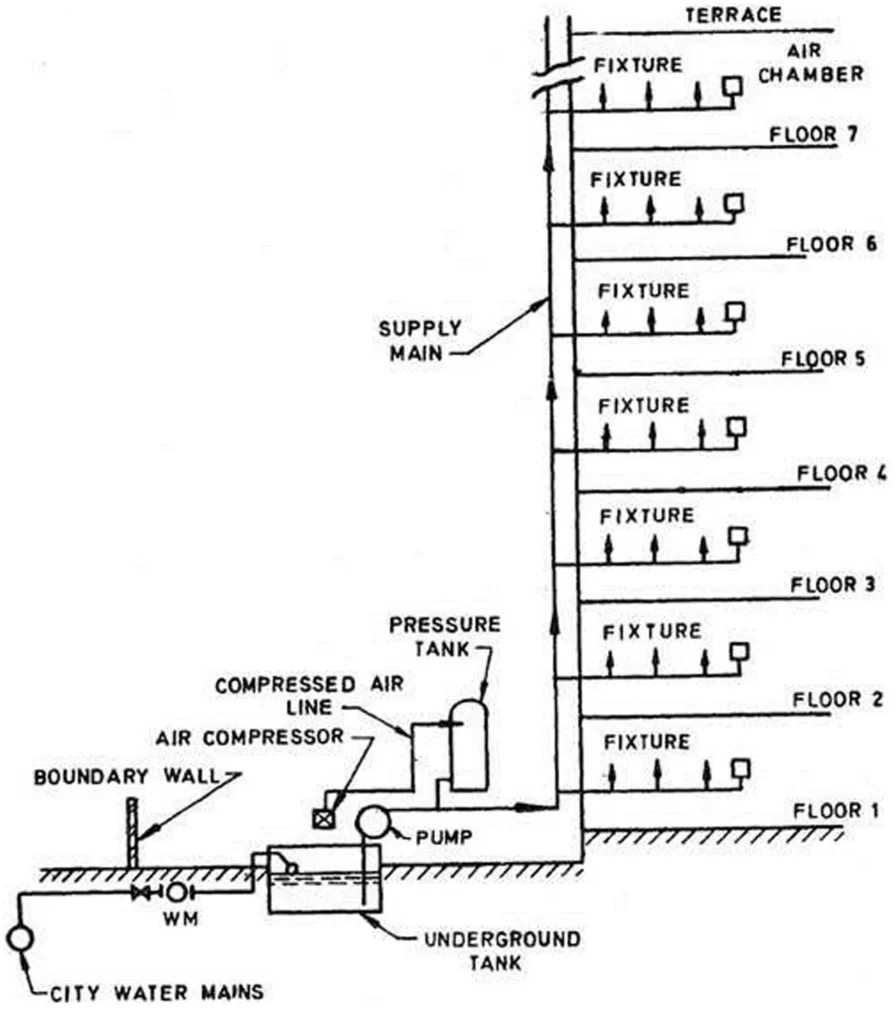
- Hydro-pneumatic system is a variation of direct pumping system.
- Hydro-pneumatic system generally eliminates the need for an over head tank and may supply water at a much higher pressure than available from overhead tanks particularly on the upper floors, resulting in even distribution of water at all floors.
- An air-tight pressure vessel is installed on the line to regulate the operation of the pumps.
- An air compressor is also necessary to feed air into the vessel so as to maintain the required air-water ratio.
For known about more advance or modern Hydro-pneumatic system please click this link
Over head tank distribution
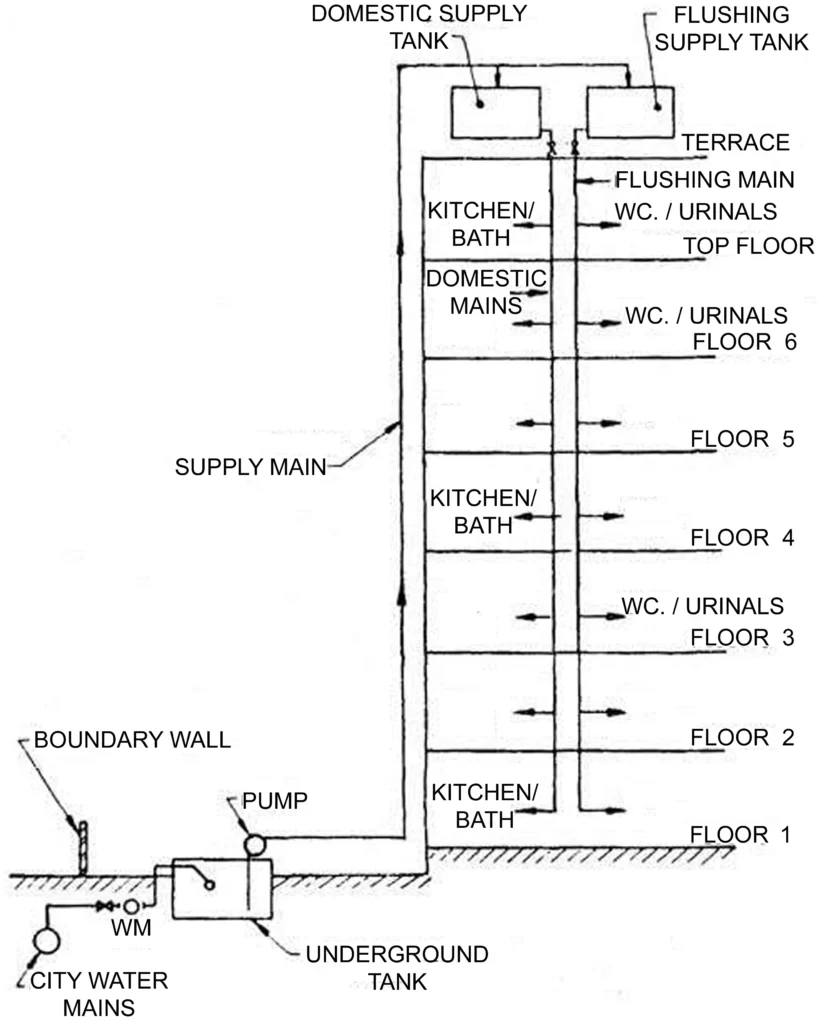
- This is the most common of the distribution systems adopted by various type of buildings.
- The system comprises pumping water to one or more overhead tanks placed at the top most location of the hydraulic zone.
- Water collected in the overhead tank is distributed to the various parts of the building by a set of pipes located generally on the terrace.
- Distribution is accomplished by providing down takes to various fixtures.
5) Design of distribution system
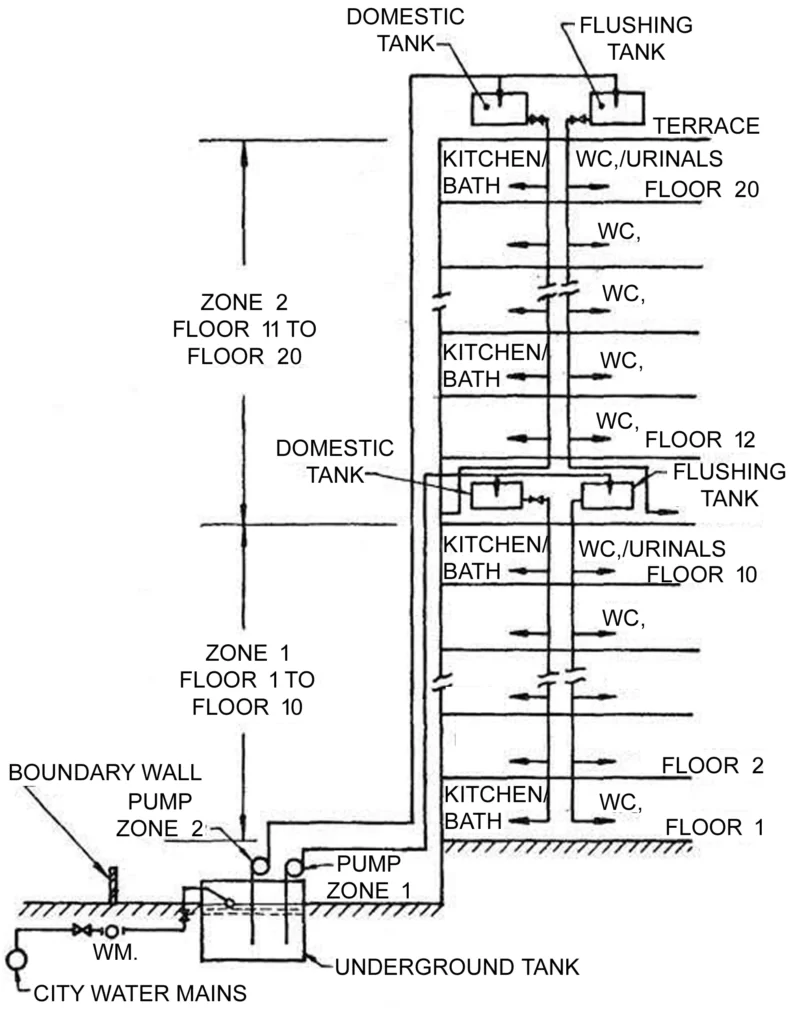
- Distribution system in a multi-storeyed building should be designed to provide (as far as practically possible) equitable flow and pressure at all the floors.
- Care should be taken to obtain the flow required for the minimum pressure at all parts in the building.
- Excessively high pressure should be avoided on every floor.
- In tall buildings, the building should be divided in vertical hydraulic zones so that the static pressure in any zone does not exceed 24-30m.
- Wherever static zones are necessary, water shall be supplied to each zone from an overhead tank located at least 3 m above the zone.
For known about more advance or modern (For tall building) Distribution system please click this link
6) Designing of piping system
- Designing of the piping system should be done by considering the pressure loss at each level and head available at that level for the required flow.
- It is recommended that the velocity of water in pipes should be restricted to 2.0 m/s to avoid noise problem.
- Systems connected to hydro-pneumatic or direct pumping systems should be provided with suitable air chambers for protection against water hammer and noise problems.
- Adequate anchorage and support to pipes below and above floors or at ceiling level should be provided.
- Provision for expansion in pipe lines in the building structure should be made.
- Pipes should be designed to withstand the additional pressure due to water hammer.

The design, construction, operation, and maintenance of water supply systems are subject to stringent regulations, aimed at ensuring that the water supply is safe and reliable.